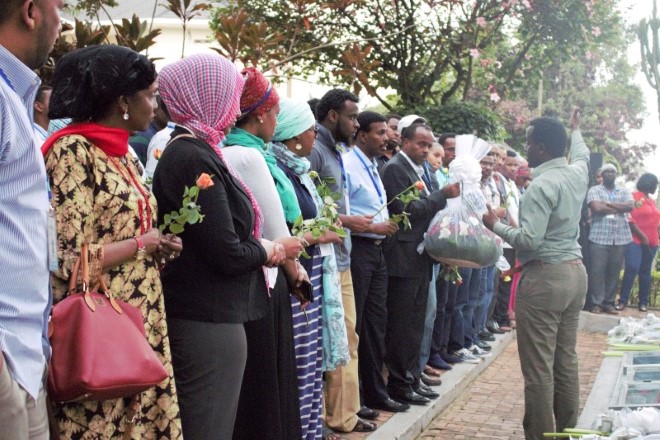
Somali Diaspora pay respect to the victims of the Rwanda genocide - Photo: HOL
by Miski Osman
Saturday, January 17, 2015
Driving through Kigali, one would never think that one of the most gruesome genocides of the twenty first century occurred just under 21 years ago in this country. Over a period of 100 days, the slaughter of about 800,000 to a million people were mercilessly administered not because of their skin tone but, simply, of the shape of their noses, their height and other physical features. Rwanda’s population consists of two major ethnic groups: the majority Hutu’s, the minority Tutsi’s and the real minority, fraction-like Twa. The Tutsis possessed an influential amount of political power; they were, nevertheless, the victims of the 1994 Rwanda Genocide along with the more moderate Hutu’s who did not want to participate in the killings. This brutal genocide was based on an ethnic division, with the Hutu’s taking up not only arms but also machetes to slice and slaughter the Tutsis.
Before my first trip to Kigali in late 2013, I read about it extensively and as a human I always knew it was horrific. The reality had, however, not hit me until I visited the Gisozi Genocide Memorial. The centre is divided into four sections, the first section is the mass graves outside the museum building where the remains of the slaughtered were laid to rest, the second section documents ore-genocide events, the third section focuses on the 100-day brutal genocide and the final section focused on the post-genocide reconciliation process. The partition of the museum into sections puts into perspective the build-up of the genocide, the actual event and how Rwanda as a nation has overcome of the genocide. The reconciliation process begins with a traditional court called
Gacaca courts, a typical Somali Xeer system, where the perpetrators speak the truth and then ask the victims for forgiveness. However, if the victim does not accept the apology in the first round, the perpetrator will have to be persistent until forgiveness is granted. This is astonishing in the sense that it provides the necessary closure for the survivors to heal; something apparently only Rwandans can do!
From the political perspective one thing that caught my eye was that the Rwandan parliament building still had the bullet scars from an attack that took place during the 1994 civil war. Although the building has been refurbished and modernized with an extension, we are told that, the scars still remain as a reminder to the people of Rwanda so that they do not go back.
Nonetheless, the Rwandan Diaspora played a critical role in helping reconstruct a new Rwanda by launching an initiative called ‘‘the one dollar campaign village’’ which was to house victims of the genocide. Some of the criteria used include the needs of the orphans, whether they had siblings to look after them or if they are a stand-alone orphan. The one-dollar campaign focused on collecting donations of a minimum 1-dollar from each and every Rwandan; whether they live inside or outside the country. The money raised was used for the building of a complex that houses 160 students currently, with some plans for greater expansion. What makes this initiative phenomenal, however, is the fact that the Rwandan Diaspora took it upon themselves to embrace their social responsibility -- personal, corporate or otherwise -- and protect the young people who were victims of the genocide. This initiative demonstrates not only the positive impact but also the level of determination, will and commitment by all Rwandans as they are committed to see their country progress, making an investment from their own pockets.
In the process of obtaining a holistic understanding of the reconciliation process, we travelled to a de-mobilisation and reintegration centre (Mobuto), that was close to the Rwandan–Congolese border. The centre accommodates Rwandan ex-combatants who lived in the nearby forest. The process of demobilising and re-integrating them back into society is extraordinary. The ex-combatants are being educated as they are taught a number of important skills in addition to exposing them to issues like how to utilise the banking system, the history of Rwanda and current affairs. This type of education is critical in the reintegration process as it enables them to comprehend the major progress the country has made since. The programme lasts for three months and once completed the ex-combatants return to their families and their communities with a new perspective; and the centre also continues to support them as they embark on a new beginning to living a normal life and being accepted into the community all over again.
In conclusion, Somalia and Rwanda are countries who share one major characteristic, among many, in common: the division within their citizens based on a social construct yet Rwanda has taken a different route in overcoming this after realising that what unites them is far greater than what divides them as a nation. There is a very important lesson that we, as Somalis, can learn from Rwanda. For example, we can put together a Somali Diaspora Fund (SDF) o help reconstruct and develop a new Somalia, fund educating the army, help with electoral processes including the cleaning process of the provisional constitution among other issues. Since going through the so-called civil war, which is not really civil at all, is not something that is solely unique to Somalia. But, how we shall or should overcome these obstacles and reclaim our place in the international arena is what shall define us. Current wrangles over cosmetic issues aside, our foundation as a nation is unstable and this is where, like the Rwandans, we should focus.
Miski Osman
[email protected]
Programme Coordinator- 13 Plus (Team London)